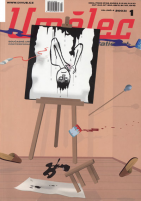| Revista Umělec 2003/1 >> Terror = Décor: Art Now | Lista de todas las ediciones | ||||||||||||
|
|||||||||||||
Terror = Décor: Art NowRevista Umělec 2003/101.01.2003 Zuzana Štefková | venice biennale | en cs |
|||||||||||||
|
Despite the fact that the Slovenian exposition Terror = décor: art now in Venice cam away with no prizes, it ranks alongside some of the most interesting projects in this summer’s Biennale. Žiga Kariž works with the theme of the commodification of violence in his project, with the viewpoint that artwork comes back to the viewer.
The equation Terror = décor contains different possible readings for this project. The first interpretation deals with the way in which art appropriates drastic subjects and transforms them into objects of esthetic interest. Most of the pictures/objects capture scenes whose violent content is subordinate to the cold esthetics of luxurious design, suggestive of the screen surfaces of a home cinema. (The presence of one image with a light Mondrianesque composition neutralizes the portrayal of violence, and allows the abstract quality to emerge.) On the other hand we could reverse the formula and interpret the result (Décor = terror) as a warning against the trap in which the pictures/objects are hiding: the fisheye of the camera films everything happening in front of the pictures. Thus it is impossible to reduce the whole project to the objects physically present in the gallery. The indivisible component he creates is more than anything a system beyond the picture (in the metaphorical and factual meaning of the word), which casts the viewer in the role of the observed. We are able to understand the theme of the reciprocal view, in which image captures the viewer, in the context of art history (in the catalogue the curator of the pavilion, Jurij Krpan, mentions, for example, work by Velázquez and Manet), but at the same time purely contemporary associations of a somewhat sociological nature emerge. The viewer knows that his movement in the gallery is being monitored, and at the same time he watches several screens broadcasting events in Venice homes, in which other pictures/objects were placed. The project Terror = décor then opens up the theme of medialization of privacy, and at the same time the extent of the control which the average citizen exhibits as he moves through public space. Privacy in our time has become a very touchy subject, whether it is at the center of attention in the voyeurism of nosey journalists, the sensational audience that compliments the total exhibitionism of participants in television contests like Big Brother, or in the possibilities of taking advantage of the camera industries and other technologies intended for our protection. Uncovering the mechanism of pictures/objects leads the viewer to reconsider his own role in the entire system, where in place of the traditional economic view the viewer/picture functions with a certain ambiguity. The viewer becomes a participant in a scene observed by the invisible eyes of someone else. Aside from these interactive aspects, we also find in the exposition artifacts dealing with the problem of the commodification of artwork, its reduction to being merely an object on the market, especially characterized by market value. His map of world art centers with the listed number of galleries, collections, artists and art market turnover is (like the entire Slovenian exposition) a part of the wider intention to map out “what causes the movement of pictures” (see the catalogue for the Slovenian pavilion, text by Blaž Križnik), in other words, what are the rules of law at play in art in its socio-political, economic and historical contexts. However the key question the Slovenian exposition asks is whether pictures can be something more than mere decoration in a world of terror, and it seems that the work of Žiga Kariž offers a positive response by means of deconstructing the mechanisms of the art market and the function of representation, or as we can read in Igor Zabel’s Bomba v obraze (Bomb in the Picture), published in the catalogue for the Venice exposition: Art can “overcomes its own limitations only by uncovering its own situation.”
01.01.2003
Artículos recomendados
|
|||||||||||||





Comentarios
Actualmente no hay comentariosAgregar nuevo comentario